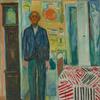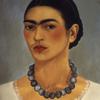The Davis Museum Challenges the Expected in Art_Latin_America: Against the Survey
- WELLESLEY, Massachusetts
- /
- February 08, 2019
The Davis Museum at Wellesley College presents Art_Latin_America: Against the Survey, an exhibition highlighting important works of modern and contemporary Latin American and Latinx art from the Museum’s extensive permanent collections. The show features 150 objects by nearly 100 artists—including 32 women—from Argentina, Bolivia, Brazil, Chile, Colombia, Cuba, Mexico, Puerto Rico, Uruguay, and Venezuela. Also represented are U.S. and European artists who worked in Latin America, as well as many of Latin American descent based in the United States. The exhibition, on view in the Camilla Chandler and Dorothy Buffum Chandler Gallery and Marjorie and Gerald Bronfman Gallery, will run from February 7 through June 9, 2019.
“Using the diversity of the Davis Museum collection as a case study—especially in terms of artists’origins and interests—we are hoping to shake things up and break new ground for the way museums present ‘Latin American Art’,” said James Oles, Adjunct Curator of Latin American Art at the Davis Museum and Senior Lecturer in the Art Department at Wellesley College. “The selection of works will surprise both specialists and our broader public, and will hopefully serve as a springboard for debate, launching fresh ideas and innovative scholarship.”
Art_Latin_America emerged from the Davis Museum’s desire to bring its expansive collection of“Latin American art,” formed mainly over the past two decades, to public attention for the first time, and to align its presentation with recent historiographic and curatorial advances in the field. The checklist was shaped by expanding the parameters as broadly as possible, an approach signaled by the underscores in the title. On one side Art, from abstract paintings to photo-journalism; on the other
America, understood broadly. Between them, “Latin” refers to that particular part of the hemisphere colonized by Spain and Portugal. The underscores of the title function as productive gaps for new meanings, suggesting rather than restricting what goes in between. The first —"Art_Latin” — means that we include art from Latin America, art of Latin America, art made in Latin America but also artabout Latin America, or even simply related to Latin America. Crucially, this includes work by artists visiting the region from elsewhere, sometimes with profound impact on local artists (such as Edward Weston and Tina Modotti in 1920s Mexico) and by those who passed through relatively unremarked (Walker Evans in Cuba, Danny Lyon in Colombia, Ann Parker in Guatemala).
The second — “Latin_America” —questions where art was produced. Most survey exhibitions in the field follow the map, using the Rio Grande as a powerful dividing line. They include works produced outside of the region by artists born there, and by émigrés and exiles who moved to Latin America. However, they often exclude artists of Latin American descent born in the mainland U.S. and Puerto Rico. The gap between Latin and America in the title thus stands not so much for missing articles or verbs as for single characters: one is the hyphen, which ties together the words, but others — o, a, @, x— push them further apart, amplifying the pool to bring in works by Latinos and Latinas, as well as artists who seek gender neutrality though new terms like Latin@ and Latinx.
The exhibition is organized in eight thematic sections: Identity and Territory, War and Loss, Protest and Propaganda, Farmers and Workers, City and Country, Saints and Rituals, Models and Mothers, and Gesture and Geometry. Each includes works across media from different periods and locations, including the U.S., and juxtaposes the expected and unexpected.
For example, viewers will see intimate surrealist visions by María Izquierdo and Alice Rahon, abstract compositions by Lygia Pape and Fanny Sanín, and photographs by Manuel Álvarez Bravo and Grete Stern. Also included are major paintings by Roberto Matta, Francis Alÿs, and Liliana Porter, drawings by José Clemente Orozco and Joaquín Torres-García, prints by Diego Rivera and Rufino Tamayo, and sculptural works by Alfredo Jaar, Jesús Rafael Soto, and Ana Mendieta.
Many objects have been rarely seen or published, and some are by artists unfamiliar even to experts. These include political prints by Uruguayan artist Leandro Castellanos Balparda, as well as Sergio Sergi and Abraham Regino Vigo from Argentina, and several recent acquisitions, such as vibrant abstract paintings by Puerto-Rican artist Olga Albizu and Mexican artist Myra Landau.
Building the Collection
At Wellesley College, works of art from Latin America, or by Latin American and Latino artists, entered the museum sporadically beginning in the 1950s, but in the past two decades interest has intensified. The Davis Museum now houses over 550 works that can be connected to the region broadly known as“Latin America,” whether as site of production, place of origin, or point of reference. The holdings are a fundamental part of the curriculum in several academic departments at Wellesley, and also serve as a vital regional resource.
Catalogue & Contributors
The works included in Art__Latin__America are further explored in a fully-illustrated publication, designed by the award-winning firm of Stoltze Design. The catalogue includes an introductory essay by the curator, followed by 70 object entries of varying lengths commissioned from 40 leading artists, scholars, curators, and collectors from across the Americas. Providing new readings of both famous and overlooked artists and works, the catalogue will be a major resource, posing a challenge to canonical representations and overviews of Latin American art and reveling in discoveries as well as unresolved issues.
Related Exhibition: Disappearances
Concurrently with Art_Latin_America, the Davis presents Disappearances, an exhibition that signals the richness of video work from the past decade. Presented in the Joan Levine Freedman ’57 and Richard I Freedman Gallery, videos by three leading Latin American artists refer metaphorically to those who have vanished because of state crimes and political violence.
-
In 4000 Shots (2010; 60 min.), Brazilian artist Jonathas Andrade (b. 1982) shows a rapid-fire sequence of men caught unaware on the streets of Buenos Aires, which recall the black-and- white photographs of the disappeared.
-
Earth (2013; 33 min.), by Guatemalan artist Regina José Galindo (b. 1974), documents a tenseperformance in which an excavator carves out a burial pit around the artist’s naked body.
-
Claudia Joskowicz (b. 1968), originally from Bolivia and now an assistant professor at Wellesley College, presents Some Dead Don't Make a Sound (2015; 10:30 min.), a mournful yet lyrical homage to the disappearance of 43 Mexican students in the town of Ayotzinapa.
Disappearances is generously supported by the Mildred Cooper Glimcher '61 Endowed Fund.


_Hiba_Alyawer__Epic_Dream__2022_Acrylic270x400_c.jpg)



__A270x400_c.jpg)







100x100_c.jpg)







